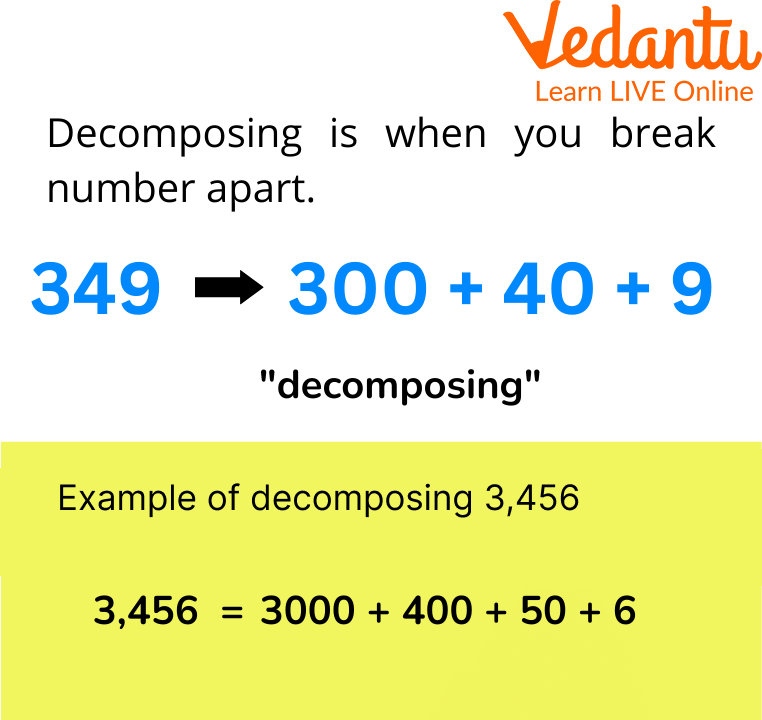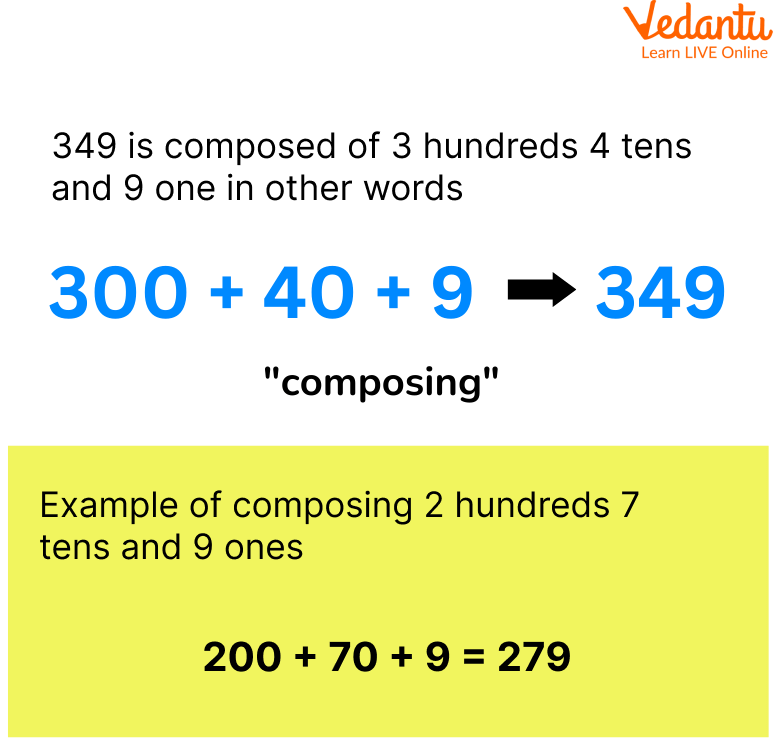




How to Practice Composing and Decomposing Numbers Efficiently
Do you know what composing and decomposing numbers mean? In this article, you will gain complete information about composing and decomposing numbers for kindergarten, along with the difference between them. This article will also assist teachers and parents in gaining new ideas about how to teach composing and decomposing numbers to children. Some composing and decomposing numbers worksheets are given to help students in mastering the concepts. So let's begin with the topic.
Define Composing and Decomposing Numbers for Kindergarten
Composing in maths is defined as a way of putting numbers together using their parts. Here many values are added together to obtain the total value. A number is represented as the sum of its various place values. When such values are combined or put together, the result is a standard form number. For example, 349 = 300 + 40 + 9.

Composing Numbers
Decomposing in maths is defined as a way of breaking down numbers into parts. A number can be broken down into its various parts based on place values. For example, 3,456 = 3000 + 400 + 50 + 6

Decomposing Numbers
What is the Difference Between Composing and Decomposing Numbers?
We have learned about composing and decomposing numbers for kindergarten. Now, what is the difference between composing and decomposing numbers? Some differences between composing and decomposing numbers are stated below:
How to Teach Composing and Decomposing Numbers
Let us now discuss some steps on how to teach composing and decomposing numbers.
Using flashcards and anchor chart:
Flashcards and anchor chart made with the students helps them in learning the concept of composing and decomposing numbers
Introducing whole and parts:
Whole groups and parts help the students in learning how to compose and decompose the numbers easily
Using maths games:
Learning to compose and decompose numbers using games is very beneficial to build one's problem-solving skills. These can also be board games.
Solved Examples
Q1. Compose the number 9000+20+3 and verify the result.
Ans: To compose the given number, write it in terms of its place value and then perform addition corresponding to each place value, i.e. 9000+23, which equals the number 9023.
To verify the result, we need to decompose the obtained number, which is done by breaking the number in terms of its corresponding place value, i.e. thousands, hundreds, tens, and ones. 9000+000+20+3, which equals 9000+20+3. Thus the answer is verified.
Hence the composed number is 9023.
Q2. Decompose the number 386.
Ans: To decompose the number, we need to break the given number, 386, in terms of its corresponding place value. As the number has hundreds, tens and ones place values, it can be broken down as 300+80+6.
Hence the result of the decomposing number 386 is 300+80+6.
Practice Questions
Q1. Compose the given number
10,000 + 4,000 + 20 + 9.
Ans: 14029
Q2. Decompose the number 56.
Ans: 50 + 6
Q3. Compose the given number and verify the result obtained.
100 + 30 + 2
Ans: 132
Composing and Decomposing Numbers Worksheet
Q1. Decompose the given number 4156.
Ans: 4000+100+50+6
Q2. Compose the number, 5000 + 20 + 8.
Ans: 5028
Q3. Decompose the given number 963.
Ans: 900+60+3
Summary
Summing up here with composing and decomposing numbers for kindergarten. In this article, we studied composing which means putting numbers together, and decomposing which means breaking down the numbers in parts. Here we have covered; what is the difference between composing and decomposing numbers along with the methods of how to teach composing and decomposing numbers. Some practice questions are given based on the solved examples that will help the students grab the topic easily. Composing and decomposing numbers worksheets are also provided for practice.
FAQs on Composing and Decomposing Numbers Made Easy
1. What does it mean to compose and decompose numbers in Maths?
In Maths, composing numbers means putting parts together to make a whole number. For instance, you can compose the number 10 by adding 7 and 3 (7 + 3 = 10). Decomposing numbers is the opposite; it means breaking a whole number down into its parts. For example, the number 10 can be decomposed into 7 and 3, or 5 and 5.
2. What is the main difference between composing and decomposing numbers?
The main difference lies in the operation. Composing is like building or adding parts to form a total number (e.g., 50 + 6 = 56). Decomposing is like breaking down or separating a total number into its smaller parts, often based on place value (e.g., 56 = 50 + 6). Composing brings numbers together, while decomposing takes them apart.
3. How can you compose the number 7 in different ways?
The number 7 can be composed, or made, in several different ways by adding smaller numbers. This helps children understand that numbers are flexible. Here are a few examples:
- 6 + 1 = 7
- 5 + 2 = 7
- 4 + 3 = 7
- 7 + 0 = 7
4. Can you give an example of decomposing a two-digit number like 45?
Yes. Decomposing a two-digit number like 45 means breaking it down into its place value parts, which are tens and ones. So, to decompose 45, you would separate it into 4 tens (which is 40) and 5 ones (which is 5). The decomposed form is written as 40 + 5.
5. Why is it important for students in Class 1 and 2 to learn how to compose and decompose numbers?
Learning to compose and decompose numbers is a foundational skill for students in Class 1 and 2. It is crucial because it:
- Builds strong number sense by showing how numbers are constructed.
- Makes mental maths easier for addition and subtraction.
- Helps students understand the fundamental concept of place value (tens and ones).
- Forms the basis for more complex maths topics in later grades.
6. How does understanding composing and decomposing numbers help with learning addition and subtraction?
Understanding how to break apart and put numbers back together directly helps with addition and subtraction. For example, to solve 15 + 8, a student might decompose 8 into 5 and 3. They can then easily add 15 + 5 to make 20, and then add the remaining 3 to get 23. This strategy, called 'making ten', turns complex calculations into simpler steps and improves mental maths fluency.
7. What are some simple methods to teach children how to decompose numbers?
Simple, hands-on methods are very effective. One popular tool is the ten frame, where counters are placed in a 2x5 grid, making it easy to see parts of 10 (e.g., 7 counters and 3 empty spaces). Another method is using number bonds, which are simple diagrams showing a 'whole' number connected to its 'parts'. Using physical objects like blocks or beads to physically separate a group into smaller groups also makes the concept tangible and easy to grasp for young learners.























